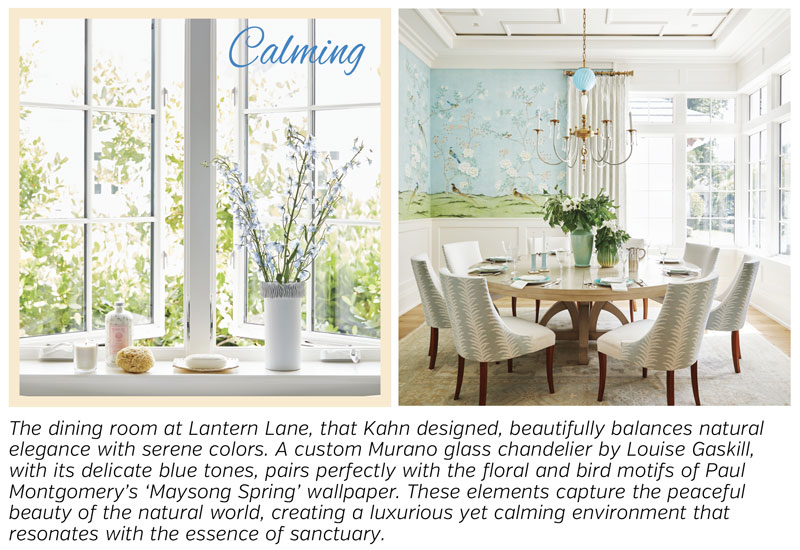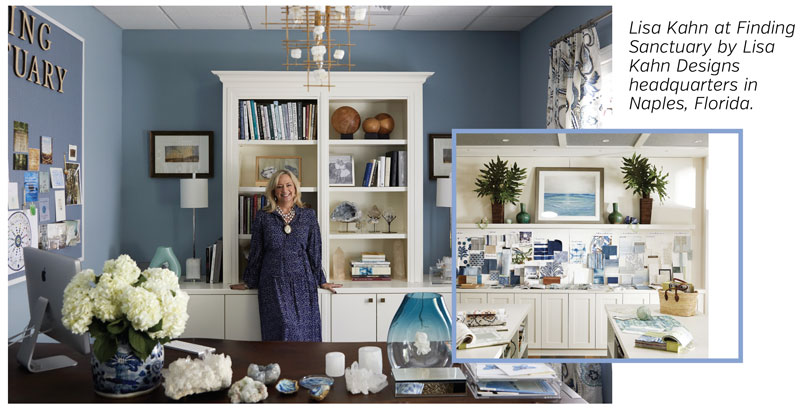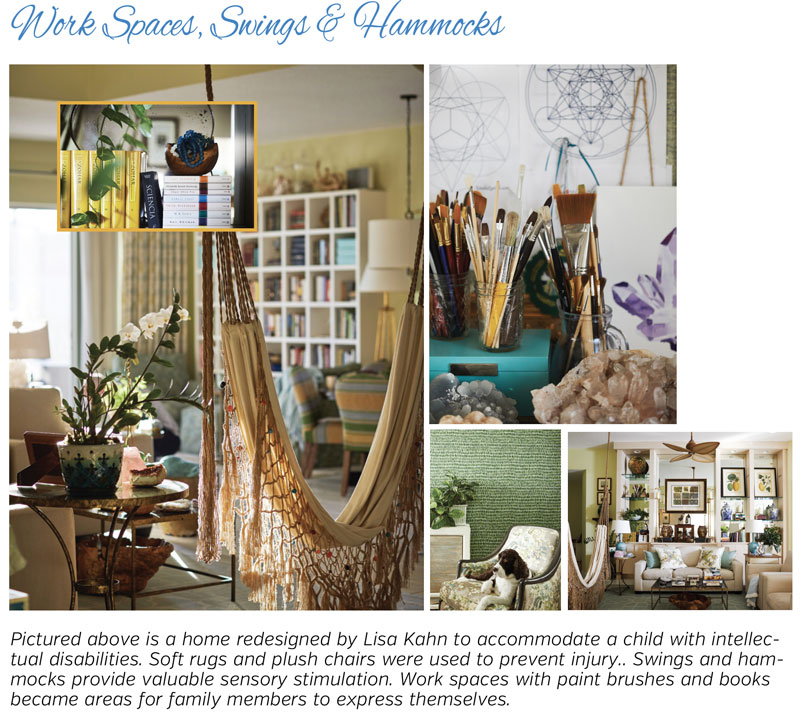INTERVIEW WITH DESIGNER LISA KAHN
Lisa Kahn brings health and wellness into homes and addresses the special needs of families. She believes furniture
retailers are missing an opportunity to do something similarly wonderful.
Finding Sanctuary by Lisa Kahn Designs is an award-winning interior design firm in Naples, Florida, founded by Lisa
Kahn.
She and her team create residential and commercial spaces that address the comfort of the body, the curiosity of the
mind and the nurturing of the spirit.
That might seem a lofty goal for the average furniture store and removed from the day-to-day business of retail, but
Kahn disagrees. She believes that her firm’s specialized design work addresses a pressing need in the marketplace and
one that also presents an opportunity for furniture retailers.
Sanctuary Beginnings
Kahn was introduced to the furniture business at a young age. “My parents founded an office supply business in Ohio,
that quickly became home and office design center. My mom took classes to become an interior designer, so as my youngest
self, I was surrounded by the design world. Their plan for me was to study interior design. Instead, in my freshman year
of college, I chose to study business.”
As she began classes, Kahn soon realized that she wanted a more hands-on creative outlet and switched to a design
concentration while continuing to work at the family’s retail store.
“I was able to take the three-part NCIDQ exam within a year of graduation and was hired as the corporate interior
designer for Lutron Electronics, a supplier of residential and commercial lighting controls. Lutron is an incredible
company. My experience there gave me an appreciation for beautiful, quality lighting design and a grounded experience in
educating my peers.”
After leaving Lutron, Kahn worked for a residential interior designer, learning the finer aspects of her craft, then
took an interior design position at London Bay Homes, a building contractor and developer in Naples, Florida.
“There, I learned the building process, acted as the liaison with designers on their projects and developed great
relationships with architects and builders.”
In 2000, Kahn started her own firm, getting a big break when she landed a large residential project on the Gulf of
Mexico, replacing a well-known, talented interior designer. “It was an eye-opening experience for a girl who grew up in
the countryside of Ohio,” she recalled, “and one that shaped the initial trajectory of my firm, which focused on serving
top one percent earners who hired me to design beautiful and unique homes.”

Life-Changing Epiphany
Kahn recalled that her life and work were upended when her daughter showed early signs of developmental and intellectual
disabilities.
“At the time, I didn’t know anyone who had a nontypical child. Nor was I familiar with the challenges that raising a
child with autism might present,” she recalled.
“Addressing this need at retail can help stores differentiate their offerings from competitors and help them
step out
with fresh, new, and next-level ideas.”
Kahn explained that following an official diagnosis at three, the medical community suggested that her daughter Chloe be
heavily medicated. “It was horrifying to watch a child’s body try to process some of the medications, and it was
impossible to reconcile how that might be good for her. Her sensory issues prevented her from sitting quietly in school;
she presented with learning issues and would act out.
“We tried all kinds of holistic therapies and remedies and consulted with doctors at major hospitals in Miami and Tampa,
Florida, and in Rhinebeck, New York.
“When Chloe turned 10, she started having seizures. And so what had been difficult behavior-wise suddenly became
life-threatening.
“Something needed to change. There were trips to the hospital; no one was sleeping, and she was falling and hurting
herself. It took a long time to find the right medications to stabilize her.
“Sleep-deprived, stressed, and needing to find a better way to cope with the situation, I had an epiphany that changed
both my family life and design career.
“I recall pausing on a bridge over a lake as the sun was starting to rise. The wind picked up, lifting my hair. I got
goosebumps from head to toe, and I promise you that I heard the word ‘sanctuary’ whispered on the wind.
“It felt like a lifeline. I visualized a place where my daughter could feel safe, secure, and calm down for everyone’s
benefit. But, since the word ‘sanctuary’ didn’t come with an instruction manual, I spent the next few years unpacking
what that word could mean.
“I hired Gail Doby, the well known interior design business coach who connected me with the communications coach Nancy
Greystone and her business, Communicating with Clarity. Nancy helped me realize what my intuition about ‘sanctuary’
meant, and how it might translate into a design philosophy.”

Sanctuary Takes Shape
“As the idea evolved, I created a sanctuary space for my daughter, addressing all of her senses. I considered how what
she felt against her skin, heard and smelled affected her moods. I believed that her unique way of experiencing the
world would benefit from the creation of a space where she felt safe and nurtured.
“We encouraged her to spend more time in her sanctuary, especially when her behavior was challenging. It had an
immediate effect. Our whole family dynamic improved and we were all able to take a collective deep breath.
“In 2000, I founded Finding Sanctuary by Lisa Kahn Designs.”
Kahn came to understand that the spaces around us affect our physical, mental, emotional and even spiritual health.
Because we spend roughly 90% of our time indoors, these environments have an outsized and profound effect on our
experience.
“As this market windfall reversed, I’ve noticed that most furniture retailers haven’t embraced the idea of
promoting
sanctuary spaces as a solution to people’s needs.”
“I realized that when we have peace around us, it inspires peace inside us—was something I could bring to the world,”
she explained. “Since then, I have spent time educating myself on ancient philosophy, various belief systems, the
science of design, neuro-aesthetics, biophilia, and neuro-architecture. I returned to school, receiving a master’s
degree in philosophy, cosmology and consciousness. The idea of sanctuary is so vast. It’s a concept that no one practice
or belief system can own.
“When COVID arrived,” she noted, “suddenly staying healthy and healing at home became critical. This also resulted in
large increases in demand for home furnishings. Yet as this market windfall reversed, I’ve noticed that most furniture
retailers haven’t necessarily embraced the idea of promoting wellness-focused spaces as a solution to people’s ongoing
needs. There is a real opportunity for our entire industry to help its customers understand how their interior
environments profoundly affect so many aspects of their lives.”

Designing Sanctuary Spaces
“I loved design before my daughter helped me find the true purpose of my design career,” she said, “but I really love
helping people transform their experience to find happier, more balanced ways of living in the world.”
Finding Sanctuary by Lisa Kahn Designs serves clients who are attracted to the idea of bringing health, well-being and
transformation into their homes. Because she is open in sharing her own story and experience, she finds that many
clients feel comfortable sharing their own personal and family struggles with her.
“It’s amazing how many families have someone in their midst dealing with mental or physical issues or challenges,” she
observed.
“Another group of clients are interested in practices like yoga, holistic living, well-being and mindfulness. I design
spaces for them, write a weekly blog, host online classes and retreats for people who want to know more about harnessing
their environments to support peace, harmony and balance. The idea of transformation is the thread that ties all of my
clients together.”

Tools And Approaches
“We do an initial deep dive with clients to learn more about their needs and set expectations upfront. They share
details of their family lives, daily routines, behaviors, habits, challenges and practices.”
Kahn said the onboarding process sets the stage for designing living environments that can transform lives. However,
people may need assistance using the sanctuary spaces we create to support continued health and healing. “We often end
up developing deep relationships with them that reach beyond designing their spaces,” said Kahn. “I welcome sharing
ideas and support to help them along their journeys.”
“Sanctuary does not have to cost a lot. It doesn’t have to be complicated. And people do not necessarily
need to hire a
designer to create it for them.”
Nature Nurture
Kahn explained that she uses many tools, materials and pragmatic approaches to create harmonious spaces for her clients.
“One strong point of reference for my design work is the natural world. Blurring the line between inside and outside
spaces is an important focus because connecting Mother Earth with interior spaces is a proven way to encourage healing
and make people simply feel better. Tying inside and outside with biophilic design principles—using shapes, natural
textures, colors, sights and sounds—is a huge part of every project.”
When Furniture World asked how furniture retailers might incorporate similar tools and approaches to attract and serve
customers, she replied, “They might start by broadening the scope of their thoughts about home furnishings from comfort,
durability and style to include more of their customers’ senses.
“It’s incredible how interior design choices can enhance well-being and calm when attention is paid to
identifying how
subtle changes in sensory experience affect mood and behavior.”
“I suggest starting with basic elements, such as color, which significantly impacts how people see and experience their
spaces. Certain colors support calming, relaxing environments. Consider bringing outside colors in to create timeless
palettes.
“Pay attention to what people are experiencing audibly in their homes. Retailers who make house calls can focus on more
than just furniture and accessories. They can notice the sounds and smells which are problematic for some people. Even
the small whine of appliance motors or HVAC systems can affect the audio balance of a space. In cases where more calm
and quiet is needed, I suggest adding beautiful background noise or music, which can make all the difference in the
world to people with audio sensitivity. The same can be true for our olfactory sense.
“We specify natural products and materials in the environments we design, preferring those that don’t off-gas or contain
volatile organic compounds. When possible, we add products that absorb some of these materials. Live plants can be
beneficial in this regard. Biophilic design that includes live plants has been shown to lower physiological markers of
stress and has the added benefit of cleaning the air and removing odors.
“The Healthy Materials Lab, a design research lab at Parsons School of Design, introduced me to Keim mineral-based
paints (https://keim-usa.com) that are sustainable and don’t contain plastics, VOCs or other toxic ingredients.
“Also consider the sense of touch. People have varying reactions to textures. Many respond positively to soft upholstery
fabrics or throws. Some people with autism may be hypersensitive or hyposensitive to touching different textured
materials, including fabrics.

“It’s incredible how interior design choices can enhance well-being and calm when attention is paid to identifying how
subtle changes in sensory experience affect mood and behavior. Finding the right balance between adding items that
enhance well-being and mitigating negative stimuli works in balance to create beautiful sanctuary environments.”
The Effect of Project Scale
“We mostly design whole homes because it’s easier to help people transform their lives in a 360-degree way. But for
people who don’t have the budget, it’s good to know that sanctuary can be created at any scale, in almost any room.
“People will benefit from setting aside some personal sanctuary space,” Kahn observed. “It can be a beautifully designed
space with a door that closes. Sometimes, a small part of a larger space that offers a bit of privacy will suffice.
Think the end of a sofa in a living room, a corner in a bedroom, even a repurposed closet.
“Being surrounded by comforting elements adds to a feeling of sanctuary. Books, art supplies, crystals, candles and pets
are comforting for me. Other people respond positively to a minimalist aesthetic and clean surfaces.”
Furniture World asked Kahn to share her feelings about how to help middle-income people, who might not be able to afford
her services, reap the benefits of sanctuary.
“I believe in my deepest heart of hearts,” she said, “that if everyone had even the smallest safe place where they could
go to recharge their battery, calm down, and connect with who they really are, the world would be radically different in
the best of ways. Sanctuary does not have to cost a lot of money or be at all complicated. People do not necessarily
even need to hire a designer to create it for them.
“I’m writing a book that explains the ins and outs of creating spaces of sanctuary, including the amazing benefits I’ve
seen it produce in the lives around me over the past 25 years. I will share the resources and tools we use at Finding
Sanctuary by Lisa Kahn Designs. I am also in the process of launching Sanctuary Consulting.
“Corporations, organizations and retailers can all benefit from encapsulating the essence of sanctuary into their spaces
and stores. And yes, I believe there is an opportunity for some furniture retailers to add sanctuary experiences to
their showrooms.
“A great start is designing store entries that project healing, positive energy to customers. Natural elements that
connect us back to the earth will convey a grounded, peaceful feeling to shoppers. Adding the right colors, textures,
sounds, and smells early on sets the mood for the remainder of a gratifying shopping experience. You never get a second
chance to make a first impression, and those impressions stick with guests as they travel throughout the rest of a
store.”
When Furniture World pointed out that some customers are only looking for an inexpensive dining set or to create a place
to entertain groups of friends who stop by to watch a big game, she observed, “It’s true that people are looking to have
different experiences in their homes, but I’ve seen that there is a largely unmet desire among consumers to find
sanctuary in their homes. Addressing this need at retail can help stores differentiate their offerings from competitors
and help them step out with fresh, new, and next-level ideas.”
Serving Other Groups
“Our primary headquarters is in Naples, Florida,” Kahn pointed out, “so it makes sense for us to also serve an aging
population with mobility and health issues. We help clients downsize, often working with senior living facilities and
campuses here.
“The idea is that as our clients enter a new chapter of their lives, it’s possible and necessary to find sanctuary. I
believe that aging consumers represent another under-served market for many furniture retailers.”
“I suggest starting with basic elements, such as color, which significantly impacts how people see and
experience their
spaces.”
Community Outreach
In 2024, Kahn and her team reached out to provide sanctuary to residents of a local homeless shelter. “Instead of
continuing to do show houses, we decided to channel those marketing dollars into pro bono design jobs where we can
create lasting, meaningful sanctuary in our own community for people who need it.
“Last year, we helped our local shelter renovate cottages to create calming environments for these displaced children.
These kids differed from our typical clients, and speaking with them profoundly changed how we approached the project.
“Our focus on a natural world connection stayed the same, but a lot of our other design work was customized to meet
their unique needs.
“We are also working with the STARability Foundation, which serves intellectually and developmentally disabled adults
who have graduated from high school and lack work, community and purpose. My daughter participates in their programming.
STARability recently purchased a small university campus. We are donating our design services to upgrade their office
and programming spaces, a new event space and eventually a housing program.
“STARability participants want to feel a sense of community and to have meaningful work and activities during the day.
We worked with their team to open a resale store to support programming. The participants are now also pouring candles
containing essential oils for my Sanctuary candle line. I provide the containers, boxes, and labels. Program
participants get paid to pour the wax, package the finished product, and add a little card at the top, connecting the
purchaser of the candle with the person who created it. It’s very personal.”
Conclusion
“Over the past 25 years, I’ve learned that success for those of us in the furniture business rests on the quality of the
relationships we cultivate with customers and clients.
“A renewed focus on developing lasting relationships and meeting customers where they are allows us to create spaces
that improve their surroundings and their lives.
“The relationships we create at Finding Sanctuary by Lisa Kahn Designs result from working closely with clients to
provide sanctuary and well-being. The need for wellness and peace is greater than ever before. We as an industry are
uniquely situated to impact lives in meaningful ways.”
Russell Bienenstock is Editor-in-Chief of Furniture World Magazine, founded 1870. Comments can be directed to him at editor@furninfo.com.